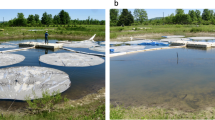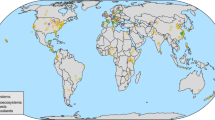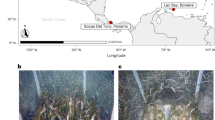Abstract
HERBIVORES can consume a sufficiently large proportion of primary production to regulate plant biomass in some environments1–3. Little is known, however, about how rates of herbivory vary among ecosystems and how herbivores influence the global distribution of vegetation. Patterns of herbivory in terrestrial ecosystems have been summarized recently4,5, but comparisons with aquatic systems are uncertain because past generalizations about herbivory in aquatic systems are based on surprisingly few data6–8. Herbivory is thought to be higher in aquatic than in terrestrial ecosystems9–11 and the impact of herbivores in aquatic systems is believed to decrease with increasing primary productivity12–15, a pattern opposite to that in terrestrial systems4,5. Here we examine these hypotheses using data from 44 aquatic sites. Herbivore biomass and herbivory rates increase at similar rates with increasing primary productivity in aquatic and in terrestrial systems. For a given level of primary productivity, aquatic and terrestrial herbivores reach similar biomass, but aquatic herbivores remove on average 51% of annual primary production, three times more than terrestrial herbivores. Mass-specific rates of herbivory are greater in aquatic than in terrestrial systems.
This is a preview of subscription content, access via your institution
Access options
Subscribe to this journal
Receive 51 print issues and online access
$199.00 per year
only $3.90 per issue
Buy this article
- Purchase on Springer Link
- Instant access to full article PDF
Prices may be subject to local taxes which are calculated during checkout
Similar content being viewed by others
References
Power, M. E., Stewart, A. J. & Matthews, W. J. Ecology 69, 1894–1898 (1988).
Feminella, J. W. & Resh, V. H. Holarctic Ecol. 12, 1–8 (1989).
Keats, D. W., South, G. R. & D. H., Steele, Mar. Ecol. Prog. Ser. 68, 181–193 (1990).
McNaughton, S. J., Oesterheld, M., Frank, D. A. & Williams, K. J. Nature 341, 142–144 (1989).
McNaughton, S. J., Oesterheld, M., Frank, D. A. & Williams, K. J. in Comparative Analyses of Ecosystems (eds Cole, J., Lovett, G. & Findlay, S.) 120–139 (Springer, New York, 1991).
Wiegert, R. G. & Owen, D. F. J. theor. Biol. 30, 69–81 (1971).
Whittaker, R. H. & Likens G. E. in Carbon and the Biosphere (eds Woodwell, G. M. & Pecan, E. V.) 281–300 (Proc. 24th Brookhaven Symp. Biol., US Atomic Energy Commission, 1973).
Pimentel, D., Levin, S. A. & Soans, A. B. Ecology 56, 381–390 (1975).
Whittaker, R. H. Communities and Ecosystems 2nd edn (Macmillan, New York, 1975).
Valiela, I. Marine Ecological Processes (Springer, New York, 1984).
Ricklefs, R. Ecology. 3rd edn (Freeman, New York, 1990).
Gliwicz, Z. M. & Hillbricht-llkowska, A. Verh. int. Verein. theor. angew. Limnol. 18, 197–203 (1972).
Eppley, R. W. in Analysis of Marine Ecosystems (ed. Longhurst, A. R.) 343–361 (Academic, London, 1981).
McQueen, D. J., Post, J. R. & Mills, E. L. Can. J. Fish. aquat. Sci. 43, 1571–1581 (1986).
Sager, P. E. & Richman, S. Can. J. Fish. aquat. Sci. 48, 116–122 (1991).
Gophen, M. J. Plank. Res. 3, 15–24 (1981).
Gulati, R. D., Siewertsen, K. & Postema, G. Hydrobiologia 95, 127–163 (1982).
Déssery, S., Lancelot, C. & Billen, G. Verh. int. Verein. theor. angew. Limnol. 22, 1504–1509 (1984).
Gulati, R. D. Verh. int. Verein. theor. angew. Limnol. 22, 863–867 (1984).
Gulati, R. D. Hydrobiologia 200/201, 99–118 (1990).
Welschmeyer, N. A. & Lorenzen, C. J. Limnol. Oceanogr. 30, 1–21 (1985).
Hart, R. C. J. Plank. Res. 8, 401–426 (1986).
Jarvis, A. C. J. Plank. Res. 8, 1065–1078 (1986).
Jespersen, A. M., Christoffersen, K. & Riemann, B. Verh. int. Verein. theor. angew. Limnol. 23, 440–444 (1988).
Van Donk, E., Grimm, M. P., Gulati, R. D. & Klein Breteler, J. P. G. Hydrobiologia 200/201, 275–289 (1990).
Van Donk, E. et al. Hydrobiologia 200/201, 291–301 (1990).
Garnier, J. & Mourelatos, S. Freshwater Biol. 25, 515–523 (1991).
Pinto-Coelho, R. M. Verh. int. Verein. theor. angew. Limnol. 24, 842–845 (1991).
Hatcher, B. G. Proc. 4th Int. Coral Reef Symp. 2, 515–524 (1981).
Carpenter, R. C. Ecol. Monogr. 56, 345–363 (1986).
Jupp, B. P. & Spence, D. H. N. J. Ecol. 65, 431–446 (1977).
Anderson, M. G. & Low, J. B. J. Wildl. Mgmt 40, 233–242 (1976).
Williams, S. L. Marine Biol. 98, 447–455 (1988).
Greenway, M. Aquat. Bot. 2, 117–126 (1976).
Verhoeven, J. T. A. Aquat. Bot 8, 209–253 (1980).
Cargill, S. M. & Jeffries, R. L. J. appl. Ecol. 21, 669–686 (1984).
Smith, L. M. & Kadlec, J. A. Ecology 66, 259–265 (1985).
Giroux, J.-F. & Bédard, J. J. appl. Ecol. 24, 773–788 (1987).
Moen, J. & Oksanen, L. Nature 353, 510 (1991).
Boyd, C. E. in Freshwater Wetlands (eds Good, R. E., Whigam, D. F. & Simpson, R. L.) 155–167 (Academic, New York, 1978).
DeNoyelles, F. & Likens, G. E. in An Ecosystem Approach to Aquatic Ecology (ed. Likens, G. E.) 161–175 (Springer, New York, 1985).
Behrendt, H. Arch. Hydrobiol. 118, 129–145 (1990).
Duarte, C. M. Mar. Ecol. Prog. Ser. 67, 201–207 (1990).
Lodge, D. M. Aquat. Bot. 41, 195–224 (1991).
Elser, J. J. & Goldman, C. R. Limnol. oceanogr. 36, 64–90 (1991).
Lubchenco, J. & Gaines, S. D. A. Rev. ecol. Syst. 12, 405–437 (1981).
Crawley, M. J. Herbivory (Blackwell, Oxford, 1983).
Hay, M. E. & Fenical, W. A. Rev. ecol. Syst. 19, 111–145 (1988).
Schroeder, L. A. J. theor. Biol. 93, 805–828 (1981).
Scott, J. A., French, N. R. & Leetham, J. W. in Perspectives in Grassland Ecology (ed. French, N. R.) 89–105 (Springer, New York, 1979).
Anderson, D. C. & MacMahon, J. A. Ecol. Monogr. 51, 179–202 (1981).
Ingham, R. E. & Detling, J. K. Oecologia 63, 307–313 (1984).
Kortright, F. H. The Ducks, Geese and Swans of North America (Stackpole Company, Harrisburg, PA, and Wildlife Management Institute, Washington DC, 1967).
Author information
Authors and Affiliations
Rights and permissions
About this article
Cite this article
Cyr, H., Pace, M. Magnitude and patterns of herbivory in aquatic and terrestrial ecosystems. Nature 361, 148–150 (1993). https://doi.org/10.1038/361148a0
Received:
Accepted:
Published:
Issue Date:
DOI: https://doi.org/10.1038/361148a0
This article is cited by
-
Herbivores’ Impacts Cascade Through the Brown Food Web in a Dryland
Ecosystems (2023)
-
A global review and network analysis of phytophagous insect interactions with ferns and lycophytes
Plant Ecology (2022)
-
High tolerance to simulated root herbivory in hydroponically grown cuttings of Salix phylicifolia
Journal of Forestry Research (2021)
-
The presence of fine sand in the muddy sediments affects habitat selection and accelerates the growth rate of Limnodrilus hoffmeisteri and Limnodrilus claparedianus (Oligochaeta)
Hydrobiologia (2021)
-
Plant apparency drives leaf herbivory in seedling communities across four subtropical forests
Oecologia (2021)
Comments
By submitting a comment you agree to abide by our Terms and Community Guidelines. If you find something abusive or that does not comply with our terms or guidelines please flag it as inappropriate.



